Summary of knowledge related to fasteners (7)
4、 Types and Structures of Steel Structure Bolts
1. Overview of bolted connections in steel structures
Bolt connection for steel structure is a method of connecting two or more steel structural components or parts together using bolts. Bolt connection is the simplest connection method in component pre installation and structural installation.
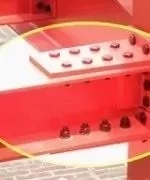 : Full bolted connection of beam column nodes
: Full bolted connection of beam column nodes
Bolt connections were first used in the installation of metal structures. In the late 1830s, bolted connections were gradually replaced by rivet connections, only used as temporary fixing measures in component assembly. In the 1950s, high-strength bolt connection methods emerged. High strength bolts are made of medium carbon steel or medium carbon alloy steel, which has a strength 2-3 times higher than ordinary bolts. High strength bolt connections have the advantages of convenient construction, safety and reliability, and have been applied in the manufacturing and installation of steel structures in some metallurgical factories since the 1960s.
Full bolt connection of picture beam splicing

2. Specification of bolts
The commonly used bolt specifications in steel structures include M12, M16, M20, M24, M30, where M is the bolt symbol and the number is the nominal diameter.
Bolts are classified into ten grades based on their performance levels, namely 3.6, 4.6, 4.8, 5.6, 5.8, 6.8, 8.8, 9.8, 10.9, and 12.9. Bolts above grade 8.8 are made of low-carbon alloy steel or medium carbon steel and undergo heat treatment (quenching, tempering), commonly known as high-strength bolts. Bolts below grade 8.8 (excluding grade 8.8, including refined ordinary bolts) are commonly known as ordinary bolts. The following table shows the performance levels and mechanical properties of bolts.
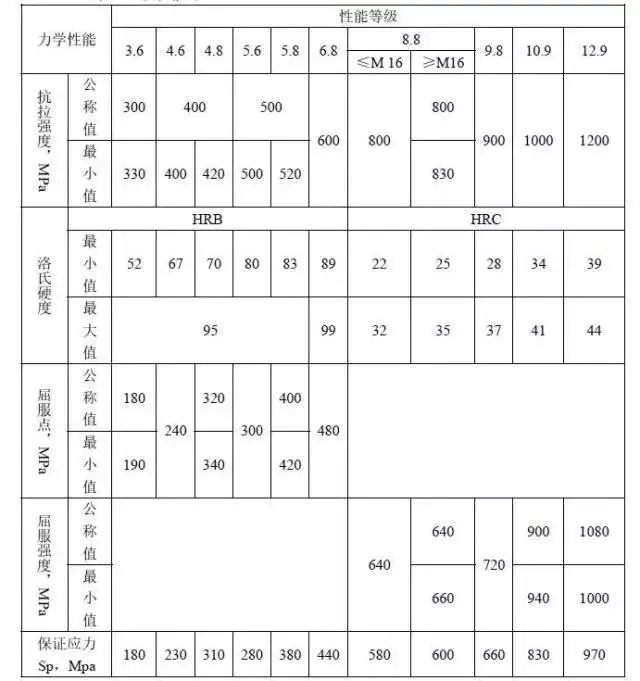
The bolt performance grade number consists of two parts of numbers, representing the nominal tensile strength of the bolt and the yield strength ratio of the material. The meaning of bolts with a performance level of 4.6 is: the first part number ("4" in 4.6) is 1/100 of the nominal tensile strength (N/mm2) of the bolt material, which means fu ≥ 400N/mm2; The second part of the number ("6" in 4.6) is 10 times the yield strength ratio of the bolt material, which means fy/fu=0.6; The product of two digits (4 × 6="24") is 1/10 of the nominal yield point (or yield strength) of the bolt material (N/mm2), which means fy ≥ 240N/mm2.
Ordinary bolts for steel structures can be classified into three levels based on their manufacturing accuracy: A, B, and C. A. B-grade is refined bolts, generally used for mechanical products, while C-grade is rough bolts. Unless otherwise specified, ordinary bolts for steel structures are generally rough C-grade bolts with performance levels of 4.6 or 4.8.
The strength design value of bolt connection adopts the values in Table 3.4.1-4 of GB50017-2003 "Code for Design of Steel Structures".
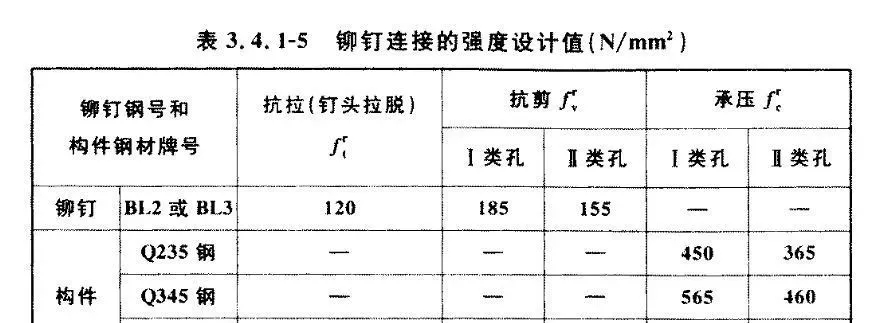
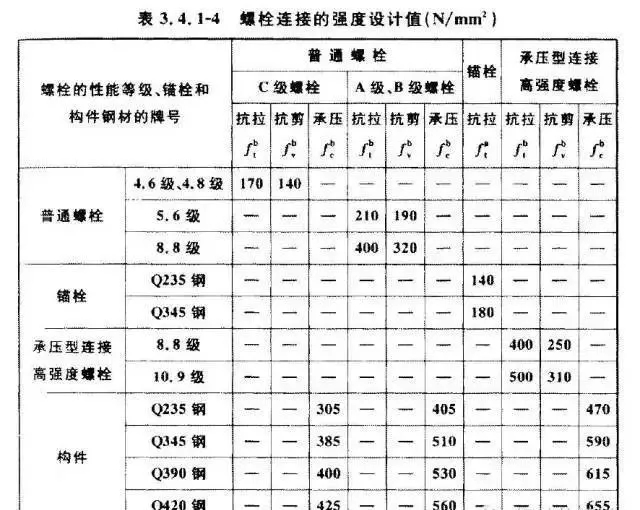
3. Classification of bolts
There are many names for bolts, such as screws, bolt studs, standard parts, fasteners, etc.
Broadly speaking, bolts include ordinary bolts, high-strength bolts, anchor bolts, expansion bolts, chemical anchor bolts, screws, bolts, etc; Narrowly defined, bolts are divided into two types: ordinary bolt connections and high-strength bolts.
(1) Ordinary bolt connection
Ordinary bolts are classified into rough bolts and refined bolts according to their manufacturing accuracy.
Ordinary bolts can be divided into hexagonal bolts, double headed bolts, countersunk bolts, etc. according to their forms.
The picture above shows a countersunk bolt
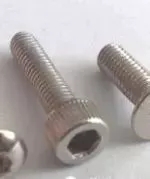
Rough bolt
C-grade bolts are generally rough bolts made of carbon structural steel. In order to allow the bolt to pass smoothly into the screw hole, the hole diameter should be 1.0-2.0mm larger than the nominal diameter d of the bolt, which is a Class II hole. The arrangement of bolt hole spacing should facilitate the tightening of nuts with a wrench. When rough bolts are used for connecting components of columns, beams, and roof trusses, a connection structure with support plates should be adopted. At this time, the bolt is in a tensile state, and its shear force is borne by the support plate (as shown in the figure below).
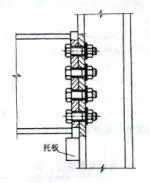
The low strength grade of the material used for rough bolts limits their range of use in structural connections, but they are still widely used in connections such as secondary beams, wall skin beams, roof beams, supports, and hinged supports with low shear forces.
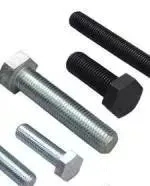
The above picture shows a regular bolt
Rough bolts are also commonly used for pre assembly of factory steel structures, pre fastening of riveted components before riveting, and temporary fastening of high-strength bolt connections before assembly and installation node welding. When using rough bolts as permanent fixing bolts, they need to be tightened and anti loosening measures taken after alignment.
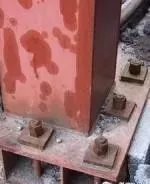
The above picture shows the double nut anti loosening measures for the column foot bolt
Refined bolts
A-grade and B-grade bolts are refined bolts, and the holes are generally Class I holes, with a diameter 0.3-0.5mm larger than the nominal diameter d of the bolt. Refined bolt connections are used for structural connections that are frequently disassembled and cannot be riveted. Refined bolts are generally used in mechanical products and are rarely used in building steel structures.
(2) High strength bolt connection
Bolts made of high-strength steel or requiring significant pre tightening force can be referred to as high-strength bolts. High strength bolts apply pre tension and transmit external forces through friction. Ordinary bolt connections rely on the shear resistance of the bolt rod and the pressure on the hole wall to transmit shear force. When tightening the nut, the pre tension generated is very small, and its effect can be ignored. On the other hand, high-strength bolts not only have high material strength, but also apply a large pre tension to the bolt, causing compression force between the connecting components, resulting in a large frictional force perpendicular to the screw direction. Moreover, the pre tension, anti slip coefficient, and steel type all directly affect the bearing capacity of high-strength bolts.

Working principle of high-strength bolts
High strength bolts are mainly divided into two types based on their stress conditions: friction type and pressure type.
High strength bolts are divided into two types according to construction technology: torsional shear type high-strength bolts and large hexagonal high-strength bolts.
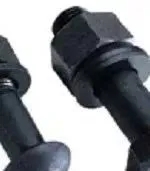
Twisted shear type high-strength bolts and large hexagonal high-strength bolts
Friction type high-strength bolt connection relies on the frictional force generated on the contact surface of the steel plate after the bolt tightening pressure makes the connecting plate layer adhere tightly to transmit external force. After sandblasting the surface of the component, a red rust surface is generated, which can achieve a higher friction coefficient and reduce the number of connecting bolts. The aperture of friction type high-strength bolts should be 1.5-2.0mm larger than the nominal diameter d of the bolt.
Pressure bearing high-strength bolt connection is used to transmit stress by simultaneously applying the frictional force between components and the shear force on the central axis of the bolt with the load-bearing force of the component. The aperture of the bolt should be 1.0-1.5mm larger than the nominal diameter d of the bolt. Drilling is carried out using methods such as CNC drilling machines and drilling molds.
In short, friction type high-strength bolts and pressure type high-strength bolts are actually the same type of bolt, with the difference being whether slip is considered in the design. In terms of design, the friction surface of friction type high-strength bolts cannot slide, and the screw does not bear shear force. Once the friction surface slides, it is considered to have reached the design failure state, which is technically mature and reliable; The friction surface of pressure bearing high-strength bolts can slide, and the screw also bears shear force, resulting in the same ultimate failure as ordinary bolts (bolt shear failure or steel plate compression failure).
The large hexagonal high-strength bolt consists of a high-strength bolt, a nut, and two washers to form a high-strength bolt connection pair.
During construction, the structure is temporarily fixed with rough bolts first. After the structure is installed and aligned, the rough bolts are replaced with high-strength bolts one by one from the middle of the bolt group and subjected to initial tightening. After initial tightening, re tightening and final tightening are carried out in sequence.
The above picture shows high-strength bolt connections with large hexagonal heads of different lengths
When installing high-strength bolts with large hexagonal heads, a washer should be added on each side of the bolt. The initial torque value is 50% of the final torque value, and the re torque value is equal to the final torque value. The formula for calculating the final torque value is: Tc=K * Pc * d. In the formula, Tc is the final torque value, measured in N · m; K is the torque coefficient; Pc is the pre tension force for construction, measured in kN; D is the diameter of the high-strength bolt thread, measured in millimeters. Torque wrench should be used for tightening, and torque correction should be performed before each use.
Twisted shear type high-strength bolt consists of a high-strength bolt, a nut, and a washer to form a twisted shear type high-strength bolt connection pair.
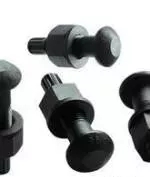
Picture torsional shear type high-strength bolt

Picture twist shear type electric wrench
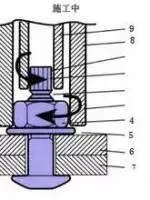
Installation principle of torsional shear type high-strength bolts
When installing a high-strength bolt connection pair with twisted shear type, only one washer should be added on one side of the nut. The formula for calculating the initial torque value is Tc=0.065 * Pc * d. In the formula, Tc is the initial torque value, measured in N · m; Pc is the pre tension force for construction, measured in kN; D is the diameter of the high-strength bolt thread, measured in millimeters. Use a specialized wrench to twist off the tail plum blossom head until it is fully tightened. The focus of quality inspection should be on the supervision and inspection of the construction process.

Post Comment